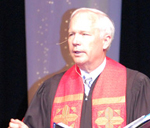 Mary Jacob’s recent article considers the role of children’s messages/sermons in worship. Most importantly, she provides perspective that allows readers to more fully consider if the practice is appropriate in their congregation.
Mary Jacob’s recent article considers the role of children’s messages/sermons in worship. Most importantly, she provides perspective that allows readers to more fully consider if the practice is appropriate in their congregation.
- It hasn’t always been this way. Children’s messages/sermons began appearing in worship services in the late nineteenth century, but didn’t become common until the 1970s and 1980s.
- Children’s messages/sermons often lack focus or are directed at a different audience than one might expect. Retired Bishop Will Willimon (pictured at right) summarized the struggle well in a blog post: “They are not for children and are usually not sermons.”
- Children’s messages/sermons put children on display and segregate them in a way that is never done for any other congregational demographic.
So What?
Every component of a congregation’s liturgy should be subject to evaluation. Strong cases can be made for and against including a children’s message/sermon in most worship services. Congregations must be intentional about knowing why they do what they do (or why they don’t do what many others do).
- If your congregation includes a children’s message/sermon in most or all services of worship, is its purpose clear to both those responsible for creating its content and those who are present when it is delivered? If so, what is your understanding of its purpose. If not, how might the appropriate leadership body(ies) approach the topic?
- If your congregation does not include a children’s message/sermon, is its omission an intentional choice or a factor of the congregation having had little recent involvement by children?
- Whether your congregation regularly, irregularly, or never includes a children’s message/sermon in worship, when was the last time the possibility was explored?